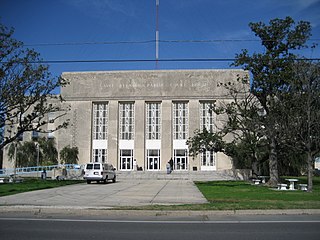
St. Bernard Parish is a parish in the U.S. state of Louisiana. The parish seat and largest community is Chalmette. The parish was formed in 1807. St. Bernard Parish is part of the New Orleans–Metairie metropolitan statistical area; the parish is located southeast of the city of New Orleans and comprises the Chandeleur Islands and Chandeleur Sound in the east.
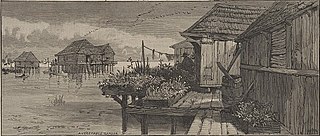
Saint Malo was a small fishing village that existed along the shore of Lake Borgne in St. Bernard Parish, Louisiana as early as the mid-eighteenth century until it was destroyed by the 1915 New Orleans hurricane. Located along Bayou Saint Malo, about 6 miles (9.7 km) east of the Isleño fishing village of Shell Beach, it was the first permanent settlement of Filipinos and perhaps the first Asian-American settlement in the United States.
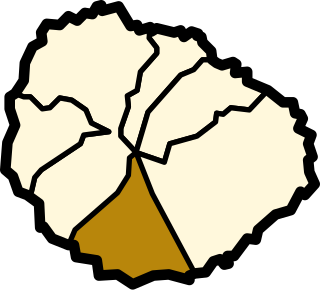
Alajeró is a municipality on the island of La Gomera in the province of Santa Cruz de Tenerife in the Canary Islands. It is located on the south coast, SW of the capital San Sebastián de la Gomera. As well as being a municipality, Alajeró is also the name of the administrative town that governs that municipality.
Isleños are the descendants of Canarian settlers and immigrants to present-day Louisiana, Puerto Rico, Texas, Cuba, the Dominican Republic, Venezuela, and other parts of the Americas. In these places, the name isleño was applied to the Canary Islanders to distinguish them from Spanish mainlanders known as "peninsulars". Formerly used for the general category of people, it now refers to the specific cultural identity of Canary Islanders or their descendants throughout Latin America and in Louisiana, where they are still called isleños. Another name for Canary Islander in English is "Canarian." In Spanish, an alternative is canario or isleño canario.
Fred. Olsen Express is an inter-island ferry service based in the Canary Islands, Spain. It operates a fleet of six modern fast ferries on five routes. Its fleet includes a trimaran fast ferry, the Benchijigua Express, which was the first such vehicle in the world when it entered service in 2005. The company is owned by the Olsen family-controlled Bonheur and Ganger Rolf, which among other things also owns the shipping companies Fred. Olsen Cruise Lines and First Olsen Tankers.

Delacroix is an Isleño fishing community and census-designated place (CDP) located in St. Bernard Parish, Louisiana. It was first listed as a CDP in the 2020 census with a population of 48. The community is also popularly known as Delacroix Island. The community was established in 1783 with the settlement of Canary Islanders along Bayou Terre-aux-Boeufs.
La Fiesta de los Isleños, often referred to as Los Isleños Fiesta, is an annual festival held in St. Bernard Parish, Louisiana, celebrating the Spanish heritage and culture of the Canary Islanders who settled in St. Bernard between 1778 and 1783. The event is hosted by Los Isleños Heritage and Cultural Society of St. Bernard, which was established in 1976. La Fiesta de los Isleños is a two-day event held at the beginning of March and hosts heritage performances by local groups as well as groups from the Canary Islands. Local bands perform in both English and Spanish as well as craftsmen and vendors display their works. Traditional Spanish food of the community is available to attendees as well as Cajun and Creole food. Dishes include Paella, Caldo, Shrimp n' Grits, as well as more American staples for the less adventurous.

Irván J. "Puco" Pérez was an Isleño folk artist and advocate for the Isleño identity. He is most well known for the singing of décimas, but he was also an accomplished woodcarver. Throughout his life, he assisted academics in the study of the Isleño Spanish language, culture, and customs.

Benchijigua Express is a fast ferry, operated by Fred. Olsen Express between the Canary Islands, Tenerife, La Gomera and La Palma in the Atlantic Ocean. She was delivered in April 2005. At 127 metres (417 ft) long, the ferry is the second-longest trimaran in the world, less than a metre shy of the Independence class littoral combat ship, which was based on Benchijigua Express's design. Her body is made of aluminium with a special offshore coating, and is the second-largest vessel with an aluminium hull. The ship's name, derived from the village of Benchijigua on La Gomera where Fredrik Olsen had property, was previously used twice since 1999.

Abtao Island is part of the Chiloé Archipelago, Chile.
Oxynoe benchijigua is a species of small sea snail or sea slug, a bubble snail, a marine gastropod mollusk in the family Oxynoidae.
Hopedale, also known as La Chinche, is a fishing community located along Bayou La Loutre in St. Bernard Parish, Louisiana. The community was established by Isleño fisherman and trappers following the American Civil War. The community was left completely destroyed following Hurricane Katrina in 2005.

Reggio, also known as Bencheque, is an Isleño fishing community located in St. Bernard Parish, Louisiana. The community was established in 1783 with the settlement of Canary Islanders along Bayou Terre-aux-Boeufs. During the last decade of the eighteenth century, Louis de Reggio purchased land from the Isleños to establish a sugarcane plantation. It is perhaps the only community in the United States that bears a Guanche-language name.
Isleños are a Spanish ethnic group living in the state of Louisiana in the United States, consisting of people primarily from the Canary Islands. Isleños are descendants of colonists who settled in Spanish Louisiana between 1778 and 1783 and intermarried with other communities such as French, Acadians, Creoles, Hispanic Americans, Filipinos, and other groups, mainly through the nineteenth and early twentieth centuries.
Canarian Americans are Americans whose ancestors came from the Canary Islands, Spain. They can trace their ancestry to settlers and immigrants who have emigrated since the 16th century to the present-day United States. Most of them are descendants of settlers who immigrated to Spanish colonies in the South of the modern US during the 18th century. The Canarians were among the first settlers of the modern United States; the first Canarians migrated to modern Florida in 1569, and were followed by others coming to La Florida, Texas and Louisiana.
Isleño Spanish is a dialect of the Spanish language spoken by the descendants of Canary Islanders who settled in St. Bernard Parish, Louisiana, United States, during the late 18th century. It has been greatly influenced by adjacent language communities as well as immigration from peninsular Spain and other Spanish-speaking countries. Moreover, the dialect spoken by the Isleños who settled along Bayou Lafourche is differentiated as Brule Spanish.

Frank Michael Fernández, Jr. was an American historian, educator, and notable Isleño advocate in St. Bernard Parish, Louisiana. Through his advocacy and exposure in the community, he attracted academics like Samuel G. Armistead, among others, to study the Isleños of St. Bernard Parish. His tenure as a public educator was marked by his fight for a Spanish language program as a means to preserve the Isleño Spanish dialect. Ultimately, his work to preserve the Canary Islander descendants community led to the formation of Los Isleños Heritage and Cultural Society of St. Bernard.
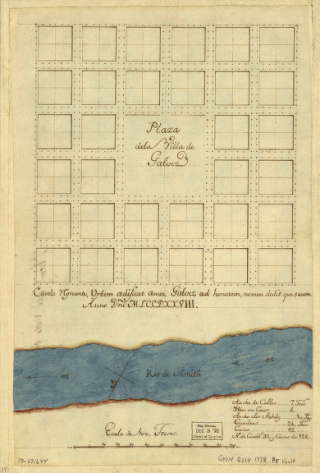
Galveztown, or Villa de Gálvez, is a ghost town located at the confluence of Bayou Manchac and the Amite River in Ascension Parish, Louisiana. Galveztown was established in 1778 with the settlement of Canary Islanders colonists and Anglo-Americans fleeing the American Revolutionary War. Due to deplorable conditions and disease, the settlement was eventually abandoned and many residents fled to Spanish Town in 1806. Some former residents remained in the area and established the community of Gálvez, Louisiana during the first half of the nineteenth century.
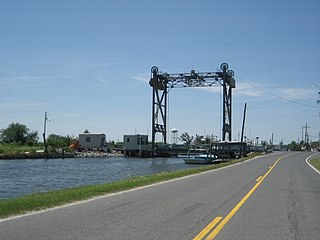
Yscloskey, also commonly known as Habitación in Spanish, is an Isleño fishing community in St. Bernard Parish, Louisiana, United States. The community is located near the coast of Lake Borgne on the northeastern bank of Bayou la Loutre and along both sides of Bayou Yscloskey. Following the American Civil War, the community was founded by Isleño hunters, trappers, and fisherman.
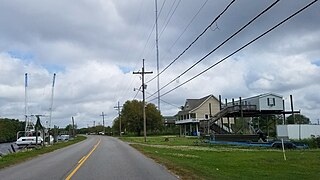
Wood Lake is an Isleño fishing community in St. Bernard Parish, Louisiana, United States. The community is situated along Bayou Terre-aux-Boeufs to the northeast of Delacroix, Louisiana and west of Lake Lery. Following the American Civil War, the community was founded by Isleño hunters, trappers, and fisherman.












